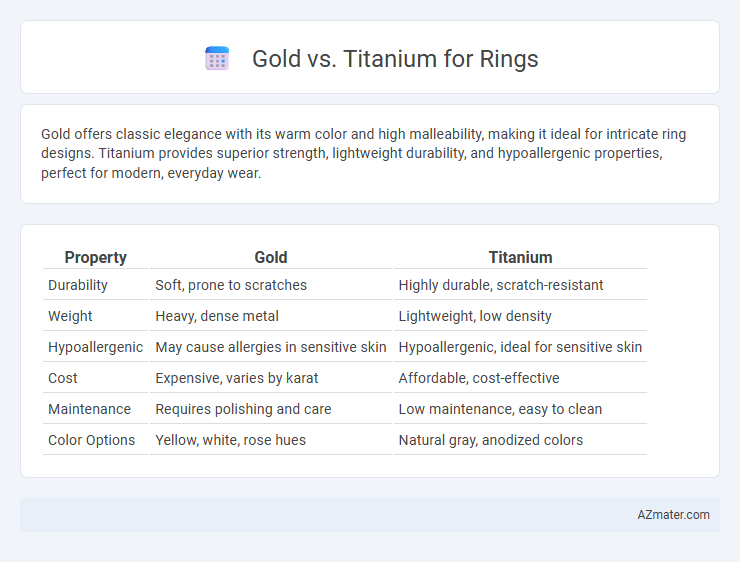Gold offers classic elegance with its warm color and high malleability, making it ideal for intricate ring designs. Titanium provides superior strength, lightweight durability, and hypoallergenic properties, perfect for modern, everyday wear.
Table of Comparison
| Property | Gold | Titanium |
|---|---|---|
| Durability | Soft, prone to scratches | Highly durable, scratch-resistant |
| Weight | Heavy, dense metal | Lightweight, low density |
| Hypoallergenic | May cause allergies in sensitive skin | Hypoallergenic, ideal for sensitive skin |
| Cost | Expensive, varies by karat | Affordable, cost-effective |
| Maintenance | Requires polishing and care | Low maintenance, easy to clean |
| Color Options | Yellow, white, rose hues | Natural gray, anodized colors |
Introduction: Choosing the Perfect Metal for Your Ring
Gold rings offer timeless elegance and classic appeal with a warm, yellow hue that signifies luxury and tradition, making them a popular choice for engagement and wedding bands. Titanium rings provide unmatched strength, lightweight comfort, and modern aesthetics with their sleek gray finish, ideal for active lifestyles and contemporary tastes. Selecting between gold and titanium depends on factors like durability, hypoallergenic properties, maintenance, and personal style preferences.
Gold vs Titanium: Overview and Key Differences
Gold rings are prized for their timeless elegance, rich color variations, and high malleability, making them ideal for intricate designs and traditional jewelry. Titanium rings offer superior durability, lightweight comfort, and resistance to scratches and corrosion, appealing to those with an active lifestyle or modern taste. Key differences include gold's higher density and softness compared to titanium's exceptional strength-to-weight ratio and hypoallergenic properties.
Durability and Strength Comparison
Titanium rings offer superior durability and strength compared to gold, as titanium ranks higher on the Mohs hardness scale and resists bending and scratching more effectively. Gold, especially in higher karats like 18K or 24K, is softer and more prone to dents and deformation with daily wear. Titanium's corrosion resistance and lightweight nature make it ideal for long-lasting, sturdy rings that maintain their appearance over time.
Comfort and Wearability Factors
Gold rings offer a traditional and luxurious feel with a smooth surface that adapts comfortably to the skin, while titanium rings provide exceptional lightweight durability and hypoallergenic properties ideal for sensitive skin. Titanium's resistance to scratches and corrosion ensures long-term wearability without the need for frequent maintenance, contrasting with gold's softness that may require regular polishing. The choice between gold and titanium significantly impacts everyday comfort, with titanium favored for active lifestyles due to its resilience and gold valued for its classic elegance and warmth.
Hypoallergenic Properties: Which is Better?
Titanium is widely recognized for its superior hypoallergenic properties compared to gold, making it a preferred choice for individuals with sensitive skin or metal allergies. Gold, especially in its pure 24k form, is less likely to cause allergic reactions but is often alloyed with metals like nickel or copper, which can trigger allergies. Titanium's biocompatibility and resistance to corrosion ensure it remains inert and safe for prolonged skin contact, providing a better option for hypoallergenic rings.
Style, Color, and Finish Varieties
Gold rings offer a timeless appeal with a warm yellow hue or elegant white and rose gold variants, providing classic style and polished, matte, or hammered finishes. Titanium rings emphasize modern aesthetics with sleek gray tones, often featuring brushed or satin finishes for a contemporary look. The choice between gold and titanium depends on personal style preferences, desired color vibrancy, and preferred texture options.
Maintenance and Care Requirements
Gold rings require regular polishing to prevent scratches and may need occasional replating for white gold to maintain their shine, alongside routine cleaning to remove dirt and oils. Titanium rings are highly resistant to scratches and corrosion, requiring minimal maintenance beyond simple cleaning with mild soap and water. Both metals benefit from avoiding harsh chemicals and impact to preserve their appearance over time.
Pricing and Value Considerations
Gold rings typically carry a higher price tag due to their intrinsic material value and traditional appeal, with 14K gold averaging around $30-$50 per gram. Titanium rings are significantly more affordable, often priced between $20-$100 for a complete band, making them an excellent budget-friendly option. While gold offers timeless elegance and potential investment value, titanium provides exceptional durability and hypoallergenic properties, delivering great value for users seeking both style and practicality.
Resizing and Customization Options
Gold rings offer extensive resizing flexibility due to their malleable nature, allowing jewelers to easily adjust ring sizes or incorporate intricate custom designs without compromising structural integrity. Titanium, while highly durable and lightweight, poses challenges for resizing because of its hardness and resistance to bending, often limiting size adjustments or necessitating specialized equipment. Customization options for gold rings are typically broader, including engraving and setting various gemstones, whereas titanium rings may require laser engraving and have fewer gemstone-setting possibilities due to material constraints.
Environmental and Ethical Factors
Titanium rings are more environmentally sustainable due to their abundant availability and lower extraction impact compared to gold, which requires energy-intensive mining with significant ecological disruption. Ethically, titanium sourcing often involves fewer labor rights concerns, whereas gold mining is frequently associated with human rights issues, including child labor and unsafe working conditions. Choosing titanium supports reduced environmental footprint and promotes responsible sourcing in the jewelry industry.

Infographic: Gold vs Titanium for Ring
 azmater.com
azmater.com